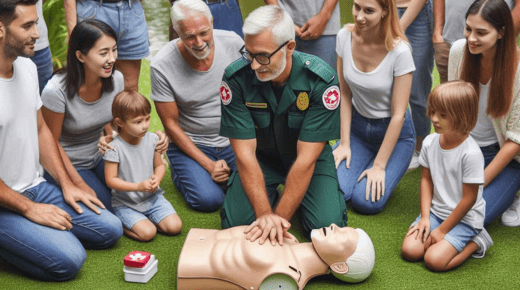Sudden Cardiac Arrest (SCA) strikes without warning, leaving little time for reaction. It’s a critical medical emergency where the heart unexpectedly stops beating, cutting off blood flow to the brain and other vital organs. Unlike a heart attack, which is caused by blocked blood flow, SCA is an electrical malfunction that disrupts the heart’s rhythm.
I’ve seen firsthand how devastating SCA can be, affecting not just the individual but their loved ones too. Understanding the signs, risks, and immediate actions to take can make the difference between life and death.
Let’s dive into what you need to know to be prepared and potentially save a life. For more information on how to prepare for and respond to medical emergencies like SCA, visit HexisCyber, where you can find resources on emergency preparedness and response strategies.
What Is Sudden Cardiac Arrest?
Sudden Cardiac Arrest (SCA) occurs when the heart suddenly stops beating effectively due to an electrical disturbance. This results in an abrupt loss of blood flow to the brain and other vital organs. The immediate cessation of heart function means the person collapses without warning and can lose consciousness within seconds.
Unlike a heart attack, SCA involves the electrical system of the heart, not a blockage that stops blood flow. Common causes include ventricular fibrillation and ventricular tachycardia, which are irregular heart rhythms. When SCA happens, the heart quivers instead of pumping blood.
Due to the critical nature of SCA, timely intervention is crucial. Cardiopulmonary Resuscitation (CPR) and defibrillation with an Automated External Defibrillator (AED) can significantly increase survival rates if administered promptly. مناطق with high incidences of heart disease often have AEDs readily accessible in public spaces for quick response.
Understanding the difference between a heart attack and SCA, knowing common causes, and learning immediate response techniques can save lives.
Causes Of Sudden Cardiac Arrest
Sudden Cardiac Arrest (SCA) can be triggered by several factors. It’s essential to know these causes to take preventive measures and reduce risk.
Genetic Factors
Genetic abnormalities often contribute to SCA. Conditions like Long QT Syndrome, hypertrophic cardiomyopathy, and Brugada Syndrome are inherited. These issues impact the heart’s electrical system, leading to irregular heartbeats. All these genetic disorders need careful management and regular medical oversight. Family history plays a significant role, so knowing one’s genetic background helps assess risk.
Lifestyle Choices And Risk Factors
Choices impact heart health. Smoking, excessive alcohol consumption, and lack of physical activity increase the likelihood of SCA. Unhealthy diets high in trans fats, sugar, and salt contribute to heart disease. All these habits and choices have cumulative effects, raising the risk over time. Stress and poor sleep quality also act as indirect factors, impacting cardiac functions.
Medical Conditions
Underlying medical conditions significantly elevate SCA risk. Coronary artery disease, the leading cause, involves blocked arteries that impair blood flow to the heart. Congestive heart failure and arrhythmias like atrial fibrillation elevate SCA risk. Other conditions include prior heart attacks, chronic kidney disease, and diabetes. Management of these conditions with medication and lifestyle changes is crucial to lower SCA incidence.
Understanding the causes of SCA empowers individuals to take proactive measures. Identifying and managing these factors with medical guidance helps prevent life-threatening events.
Symptoms Of Sudden Cardiac Arrest
Sudden Cardiac Arrest (SCA) strikes without warning but may present specific symptoms. Recognizing these signs helps initiate immediate action.
Warning Signs
Warning signs preceding SCA are often mistaken for less severe conditions. These include:
- Chest Pain: Discomfort or pain in the chest area.
- Breathlessness: Shortness of breath even at rest.
- Weakness: Sudden, unexplained weakness or fatigue.
- Lightheadedness: Feeling dizzy or faint.
- Palpitations: Noticeable rapid or irregular heartbeats.
Prompt medical evaluation is crucial if these symptoms occur.
During The Event
During an SCA event, symptoms become more severe and obvious:
- Collapse: Sudden loss of consciousness.
- No Pulse: Absence of detectable pulse.
- No Breathing: Lack of normal breathing.
- Unresponsiveness: Inability to respond to stimuli.
- Seizures: Possible convulsive movements.
Immediate CPR and defibrillation are essential. Recognizing these symptoms and acting quickly can save lives.
Diagnosis And Treatment
Recognizing Sudden Cardiac Arrest (SCA) promptly is critical. Timely intervention can drastically improve survival chances.
Immediate Response And CPR
Assessing the scene, I ensure it’s safe to approach the collapsed individual. Calling emergency services immediately is essential, detailing the situation. While awaiting professional help, performing CPR (cardiopulmonary resuscitation) sustains blood flow. I position my hands at the center of the chest, pressing down hard and fast, aiming for 100-120 compressions per minute. If an Automated External Defibrillator (AED) is available, I follow the device’s prompts to deliver electrical shocks to the heart, aiming to restore a regular heartbeat.
Medical Interventions
After emergency services arrive, advanced medical interventions begin. Professionals often administer medications like epinephrine to stimulate the heart, and initiate advanced airway management. In hospitals, additional diagnostic tests, including electrocardiograms (ECGs) and blood tests, identify underlying causes. In some cases, implantable cardioverter-defibrillators (ICDs) are recommended to prevent future episodes. Advanced imaging techniques like echocardiograms can further evaluate heart function, guiding long-term treatment strategies.
Recognizing and treating SCA involves understanding the steps from immediate response to advanced medical care, ensuring comprehensive and effective management.
Prevention Strategies
Prevention strategies for Sudden Cardiac Arrest (SCA) focus on lifestyle modifications and regular medical evaluations. These efforts significantly reduce SCA risk.
Healthy Lifestyle Choices
Healthy lifestyle choices play a critical role in preventing SCA. Exercising regularly, at least 150 minutes weekly, improves cardiovascular health and lowers heart disease risk. Eating a balanced diet, such as incorporating fruits, vegetables, and whole grains, helps manage weight and reduces cholesterol levels. Avoiding tobacco products, limiting alcohol intake, and managing stress through mindfulness or therapy further protect heart health. These measures collectively reduce SCA incidence.
Regular Check-Ups
Regular check-ups are essential in identifying and managing heart health. Visiting a healthcare provider annually or as recommended aids in early detection of heart conditions. Monitoring blood pressure, cholesterol levels, and blood sugar can help spot risk factors. Diagnostic tests, including EKGs and stress tests, evaluate heart function more accurately. For those at higher risk, discussing options like medication or wearable heart monitors with a doctor ensures proactive SCA management.
Living With The Risk Of Sudden Cardiac Arrest
Living with the risk of Sudden Cardiac Arrest (SCA) requires vigilant adherence to medical advice and lifestyle adjustments for optimal heart health. Frequent visits to a healthcare provider and open communication about heart health are essential.
Regular Medical Check-Ups
Regular medical check-ups are crucial for those at risk of SCA. During these visits, screening for heart conditions and early signs of problems happens proactively. It’s better to detect issues early than to wait for symptoms to arise. Monitoring involves routine tests, like electrocardiograms (ECGs) and echocardiograms, to catch irregular heart rhythms early.
Medication Adherence
Taking prescribed medications correctly impacts heart health significantly. If a doctor prescribes medications to manage heart rhythm or other conditions, they should be taken as directed. Missing doses or stopping medication without consulting a doctor could increase SCA risk.
Implementing Lifestyle Changes
Adopting heart-healthy habits contributes to lowering SCA risk. Implementing lifestyle changes, such as maintaining a balanced diet, regular exercise, and avoiding smoking, helps in managing and mitigating the risks. Focus on eating nutrient-rich foods that support heart health, like fruits, vegetables, whole grains, and lean proteins. Regular physical activity, like brisk walking or swimming for at least 30 minutes a day, enhances cardiovascular efficiency.
Device Implantation
For some, a healthcare provider might recommend devices like an Implantable Cardioverter Defibrillator (ICD). These devices monitor heart rhythms continuously and deliver shocks to correct irregular rhythms. Implantation, done under medical supervision, is a preventive measure for those at high risk.
Emotional Well-Being
Living with the risk of SCA can impact emotional well-being. Anxiety and stress might escalate, affecting heart health negatively. Engaging in stress-reducing activities, like mindfulness, yoga, and hobbies, is beneficial. Seeking support from mental health professionals or groups for emotional support is equally important.
Education and Preparedness
Understanding SCA and being prepared improves outcomes significantly. Learning cardiopulmonary resuscitation (CPR) and knowing how to use an Automated External Defibrillator (AED) equips individuals to respond promptly if an event occurs. Training in these life-saving techniques, often offered by various organizations, builds confidence and readiness.
Community Support
Being part of a support network can alleviate the burden of living with SCA risk. Engaging with local or online communities of individuals facing similar challenges provides emotional support, shared experiences, and practical advice. Community members often exchange strategies for managing their condition and staying motivated.
Proactive Communication
Maintaining proactive communication with family, friends, and coworkers ensures they know what to do in case of an emergency. Sharing information about one’s condition and emergency response plans equips them to act swiftly. Keeping communication clear and frequent aids in creating a supportive environment.
By adhering to these strategies, managing the risk of Sudden Cardiac Arrest becomes more systematic and less daunting.



